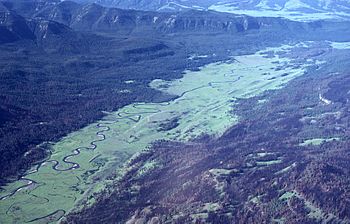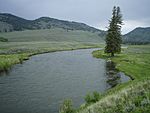Slough Creek (Wyoming) facts for kids
Quick facts for kids Slough Creek |
|
|---|---|

Aerial view of Slough Creek in 1989
|
|
| Country | United States |
| State | Montana, Wyoming |
| Physical characteristics | |
| Main source | Beartooth Mountains, Montana 45°12′32″N 110°07′10″W / 45.20889°N 110.11944°W |
| River mouth | Lamar River Yellowstone National Park, Wyoming 44°55′06″N 110°20′51″W / 44.91833°N 110.34750°W |
| Length | 25 mi (40 km) |
Slough Creek is a beautiful river, about 25 miles (40 km) long, located in the United States. It flows through parts of Montana and Wyoming, eventually joining the Lamar River. This creek is famous for its amazing wildlife and popular fishing spots, especially for a special type of trout.
History of the Name
How did Slough Creek get its interesting name? In 1867, a group of gold prospectors explored this valley. They described the area as a slough, which means a muddy or swampy place. This name then started appearing on maps as early as 1872.
There's also a story, or myth, about how the creek got its name. A soldier named John P. Slough was with an exploration team in 1873. He wrote in his diary that he got lost in the valley. When he was found, he believed the creek was named after him. However, we know the name was already used before his adventure!
Where Slough Creek Flows
Slough Creek begins high up in the Beartooth Mountains in southern Montana. It then flows southwest, making its way into the famous Yellowstone National Park in Wyoming. The creek eventually joins the Lamar River near a place called Tower Junction inside Yellowstone Park. The Lamar River then flows into the larger Yellowstone River.
The water in Slough Creek is a little bit alkaline, which means it's slightly basic. The area around the creek is a mix of fir forests, open grassy areas, and sage flats. These different plant communities are home to many kinds of animals. You might see animals like coyotes and bison living here.
Fishing in Slough Creek
Slough Creek is one of the most popular places to fish in Yellowstone National Park. It's fairly easy to get to, and the fishing for a type of fish called Yellowstone cutthroat trout is considered some of the best in the world.
The lower parts of Slough Creek, below the campground, are easy to reach from parking areas. In these lower waters, you can find rainbow trout and even mixed fish that are part cutthroat and part rainbow. The upper parts of Slough Creek can be reached by hiking trails. The first meadow is about a 45-minute walk from the start of the trail. This spot is very popular because it's close and the fishing is excellent. If you hike further, the second meadow is about a three-hour walk away.
The cutthroat trout in Slough Creek are great for dry fly fishing. This is a type of fishing where you use a fake insect that floats on top of the water. In July, many different kinds of insects hatch, like caddisflies and mayflies, which the trout love to eat. Later in the summer, other insects that live on land, called terrestrials, become important food for the fish.
In 2007, a fisherman reported catching a rainbow trout above the Slough Creek falls for the first time. This was a big deal because rainbow trout are not native to this area. When new fish are introduced, they can affect the native cutthroat trout. This can also impact other wildlife that rely on the cutthroat trout for food.
Slough Creek usually has high water levels until about the second week of July, so it's best to check with local fishing stores about conditions before you go. The National Park Service often changes the fishing rules for Slough Creek. In 2018, new rules were put in place. Fishermen are now required to remove all non-native fish they catch, such as rainbow trout and brook trout. This rule applies to the entire Lamar River area, including Slough Creek. If you catch a fish that looks like a mix of rainbow and cutthroat, you must also remove it. However, if you are not sure what kind of fish it is, it's best to let it go.
Another important rule for fishing in the park is that you cannot use felt-soled waders. Also, barbed hooks, lead weights, and live bait are not allowed. These rules help protect the environment and the fish.



